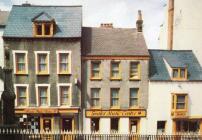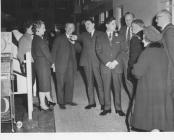Gellir lawrlwytho cynnwys at ddefnydd anfasnachol, megis defnydd personol neu ar gyfer adnoddau addysgol.
Ar gyfer defnydd masnachol cysyllwch yn uniongyrchol gyda deilydd yr hawlfraint os gwelwch yn dda.
Read more about the The Creative Archive Licence.
Disgrifiad
Photography by John Ball - 25 September 2002 (colour images scanned from prints taken with a Sigma SA-300 35mm single lens reflex camera)
Image 1:
Church of St John the Evangelist in the 19th century- viewed from the northwest. (19th century print from a steel engraving by W. Radclyffe after an original drawing by D. Cox)
History
The priory church of St John the Evangelist stands on the high ground above the River Honddu. The priory was founded, very probably on the site of an earlier church, by Bernard de Neufmarché (Bernard Newmarch) shortly after his defeat of Rhys ap Tewdwr, king of Brycheiniog, at Brecon in AD 1093 (but see note ** below).1 He gave "the church of St John the Evangelist near his castle of Brecon", together with "a certain property called the Old Town" to the newly founded Benedictine abbey of Battle in Sussex, England, at the request of one of his followers, a monk of Battle named Roger. Roger undertook the rebuilding of the church "from the foundations". Brecon remained a dependent cell of Battle Abbey until its suppression by Henry VIII in 1538. Giraldus Cambrensis (Gerald of Wales) was archdeacon of Brecon circa 1172, but little remains of the early church of this Norman period other than parts of the nave walls immediately west of the crossing.2 The choir and the transepts were rebuilt in the 13th century and the tower was added. In the 14th century the nave, and north and south aisles were rebuilt. The chancel was restored by Sir Gilbert Scott in 1862-1865, and in 1923 the church became the cathedral for the Diocese of Swansea and Brecon. The priory's domestic buildings which survived the Dissolution were restored in 1927 and now form the cathedral chapter offices.
The above historical and architectural information was extracted from:
An Architectural Study - The Cathedral Church of St John the Evangelist, Brecon by the Royal Commission on the Ancient and Historical Monuments of Wales and The Dean and Chapter of Brecon Cathedral; published by the Friends of Brecon Cathedral in 1994; ISBN 0-9523110-0-3
A Tour of the Abbeys, Priories & Cathedrals of Wales - An Itinerant's Exhibition by David S. Yerburgh, published by the author in 1999, Salisbury, Wiltshire; ISBN 0-9535635-0-2
** Note Other historical sources state that in the late 11th century, the ruler of Brycheiniog was Bleddyn ap Maenyrch, not Rhys ap Tewdwr. The latter figure was ruler of Deheubarth (southwest Wales) at this time. Both men died in the battle of 1093. Further details on this topic are available in chapter 5 (pages 80 to 93) of The Normans in South Wales 1070-1171 by Lynn Nelson. A complete transcript of this manuscript is available on-line at: http://historicaltextarchive.com/books.php?op=viewbook&bookid=68. Many thanks to Alun Chesterfield of Glyn Neath, Glamorgan, for drawing my attention to this historical anomaly. John Ball, 11 December 2002
The colour images which follow are selected from a commissioned portfolio of 132 photographs taken by John Ball in and around Brecon in September 2002 for a client in the USA.
Exterior of Brecon Cathedral
Image 2:
Tower, and north wall of Havard Chapel, viewed from the northeast.
Image 3:
North porch and entrance viewed from the northwest (compare this view with the 19th century engraving, above).
Image 4:
West wall and west window.
Image 5:
South wall and tower, viewed from the southeast.
Image 6:
East end of the cathedral (right and centre). In the distance are the canonry (left of centre) and deanery (left).
Image 7:
Tower and east window of the cathedral, viewed from the northeast.


















Oes gennych chi wybodaeth ychwanegol am yr eitem hon? Gadewch sylwad isod
Sylwadau (0)
Rhaid mewngofnodi i bostio sylw